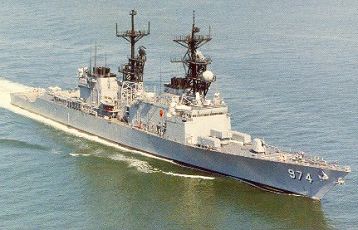In 1986 I was the vice-consul at the American Consulate General in Dubai, United Arab Emirates. It was my first assignment in the U.S. Foreign Service. My main responsibilities were providing a variety of citizen services to the American community, which numbered hundreds working in all aspects of the oil industry. In addition, since there was no functioning American Embassy in Tehran, Iran, many Iranians flooded Dubai seeking visas to the United States. I was responsible for interviewing hundreds of Iranians (and other nationalities) each day.
The U.S. Navy maintained a fleet of ships in the Persian Gulf region under the command of COMIDEASTFOR. These ships routinely made liberty calls at Dubai (and sometimes in the other northern emirates). It was my job to coordinate with the harbormaster about the docking of the Navy ships in the Dubai Dry Docks, and to provide a security briefing to the ship’s Executive Officer (XO) about potential problems for the crew while ashore.
This meant I had to ride out on the harbormaster’s pilot boat about a mile off-shore to a Navy cruiser. The sailors would lower a rope ladder on the side of the Navy ship, and with the pilot boat positioned close by, I—in my business suit—would grab hold of the rope ladder and pull myself up. In a canvas bag slung over my shoulder, I carried my briefing materials about potential security threats for the sailors. Once aboard ship, over a loudspeaker, I was piped aboard, “U.S. Vice-Consul Michael Varga now aboard ship” would ring out across the deck, and the XO would salute me once I was safely aboard.
Many times I was unsure of my grasp on the rope ladder and feared I would tumble off of it into the Persian Gulf. Fortunately, I completed my Dubai assignment without ever falling.

Five U.S. Navy ships were greeted in this manner while I was stationed in Dubai (The USS Comte de Grasse, The USS Gallery, The USS Tattnall, The USS Boone, and the USS Conolly). While the Comte de Grasse was in port, a sailor required an emergency appendectomy at Rashid Hospital and I made the arrangements for his care post-surgery.
On January 12, 1986, a U.S. American President Lines (APL) ship was intercepted by the Iranian Navy off the coast of the U.A.E. The President Taylor was boarded by seven Iranian sailors who forced the crew to assemble in one holding area of the ship as they searched it for munitions and other weapons that might be used by Iraq in its ongoing war with Iran.
The Consul General directed me to drive to Fujairah, an emirate in the north of the U.A.E., where the President Taylor docked after the seizure. This was very near the narrow Strait of Hormuz, just 21 miles wide, controlling access from the Gulf of Oman into the Persian Gulf. Fujairah is some 66 miles from Dubai and the roads not always paved and it took me more than two hours to arrive in Fujairah.
I interviewed the captain and the crew about the behavior of the Iranians. In addition, there were also some passengers (Portuguese, Korean, and Indian) who had booked transport on President Taylor. While the Iranians had trained their weapons initially on the ship to compel it to stop, and they flashed guns at the crew in the initial stage of forcing members into the holding area, once that occurred the Iranians did not further threaten the crew. The Iranians searched the entire ship and departed from it after an estimated hour and forty-five minutes. I noted what each crew member and each passenger said, often relying on a translator among the passengers, and returned to Dubai to write up my report immediately and cable Washington.
My on-site reporting allowed the U.S. to determine that while this incident was troubling, there were no additional provocations that warranted a greater U.S. official response to the seizure. For a couple of days afterward, my adrenaline remained high, having been the “point person” on the front line of interpreting what was happening in the fog of the Iran-Iraq war and its impact on American interests in the Persian Gulf.
The U.S. Navy subsequently provided an escort to some vessels traveling through the Persian Gulf as the Iran-Iraq War intensified.
This was originally published on The American Foreign Service Association Website.
You can read the original article here.
